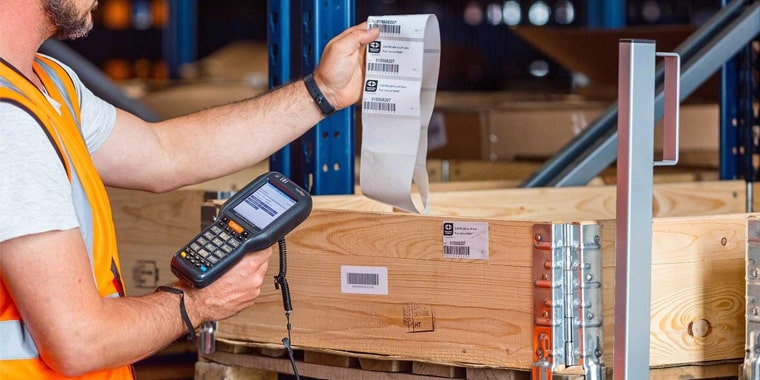
Inventory is one of the most critical assets for any business that manufactures or sells products.
But managing inventory effectively can be extremely complex.
Today we look at SKUs and their role in inventory management.
Do we have too many SKUs?
Many retailers ask this question to themselves, as they struggle to manage their inventory efficiently and try to keep costs down.
While you do need a good number of SKUs to make sure there is availability and variety of products, it also signifies that your business and logistics provider have to keep track of that many SKUs.
If you ever get the feeling that you have way too many SKUs, and it’s becoming overpowering, then it’s time for SKU rationalization to optimize your inventory.
Let’s first get a clear understanding of what SKUs are before we start discussing the rationalization process, strategies, and benefits.
ALSO READ: Inventory Reduction Strategies

A Stock Keeping Unit or SKU is a system of inventory management where you allocate a distinct alphanumeric bar code to a product’s variants.
Let’s take the example of a clothes retailer.
A polo neck T-shirt is likely to be available in a range of sizes and colors; this means separate SKUs for every variant combination.
Like, T-shirt size M color blue, size M color red, size XL color blue – you get the drift.
One product can produce even 50 separate SKUs.
However, maybe a certain color is not selling as well as the others, or some sizes are slow selling; the seller has to make a decision here.
ALSO READ: Guide on Stock Adjustment and Stock Transfer
SKUs are retailer-specific, and help in inventory management; they are unlike UPC or EAN barcodes which are universal.
These SKU codes help customers to differentiate between similar products, and in that sense, they are highly valuable to businesses.
However, too many of them means there are too many vendors, people, data, storage space, analysis, and so on.
Simplifying operations in your business is a major requirement for the efficient functioning of your business and is also critical in supply chain management.
SKU rationalization is one method you can use to achieve this objective.

In the simplest terms, SKU rationalization is the process of deciding which products to discontinue and which to maintain, to reduce the number of items and simplify business operations.
You can eliminate nonessential carrying costs and reduce other production expenses too.
This process can significantly alter the manner in which your business operates.
Therefore, you should approach this thoughtfully, and do it in a phased manner.
If you follow the proper guidelines, you should be able to reduce your SKUs smoothly and seamlessly.
When managing inventory for a product, it’s up to the merchant to decide how many SKUs they choose to have available for that item, and the quantity of each.
For example, an apparel brand selling a particular style of a t-shirt might choose to stock seven of the ten available colors offered by the supplier.
ALSO READ: What is Inventory Reorder Point(ROP)?
To use the proper definition of SKU rationalization, it is the process by which traders can measure how profitable the products they stock in their inventory are.
With the use of performance indicators like supplier fees, storage costs, carrying costs, etc. combined with sales data, retailers can take decisions regarding items that need to be discontinued or continued but with certain adjustments.
Businesses can determine if any of the SKUs are hampering or improving their business, and take requisite action to streamline their inventory and reduce costs of operations.
Any business can enjoy the benefits of regular SKU rationalization; however, it is especially critical in the case of those categories of products that have specific products with seasonal demand and are subject to high turnovers.
Examples of such products include clothes; like jackets and warm clothing will only be in demand in the colder months.
SKU proliferation is the opposite of SKU rationalization; here a seller adds more SKUs to their stock to be able to fulfil consumer demand.
This strategy is gaining popularity due to the sharp growth of E-commerce because sellers want to tap into more markets and attract as many new shoppers as they can.
Logically, more SKUs mean more variety and choice for shoppers; it also indicates having a competitive edge in the market.
ALSO READ: What is Order Up to Level in Inventory Management?
Of course, this means that you will incur more expenses in the form of labor, carrying costs and so on, and also require additional storage space, and you will also tie up more of your capital in inventory.
Your data analysis will be more complex and intensive.
All of these can be overwhelming and challenging not only for you but also for your third-party logistics service provider.
To put it succinctly, increasing your SKU counts can be expensive and draining for your business.

Storage charges, labor cost, insurance, etc. are all part of the carrying cost of inventory, and it makes up for over 30% of inventory cost on average.
After all, once you purchase products, you have to store them well and care for them till they are not just sold but packed and shipped out.
By analyzing historical sales data, you can get a good idea of how much quantity of an SKU to order, and the time to reorder it.
With an automated inventory tracking system, you can get all the data and analytics you need for calculating the turnover rate of your inventory; this metric tells you the number of times a particular inventory item is sold and replaced within a specific time period.
Tranquil simplifies monitoring costs like storage, fulfilment, and so on across your network by monitoring inventory activity – like what products are entering and leaving the inventory – in real-time, with a central and intuitive dashboard.
ALSO READ: Cost Reduction Strategies in Procurement
Tracking the stock in hand is not the only facet of inventory management; decisions have to be made regarding individual SKUs about reorder levels and times, and more.
Tranquil inventory management software tracks performance of SKUs over specific periods and delivers important KPIs like demand forecasting, SKU velocity, inventory turnover rate, etc.
With Tranquil, you can easily track SKUs, enabling you to see, administer, and alter SKUs whenever you want.
It also facilitates the bundling of products so that you can sell of slow-moving SKUs with hot-selling ones.
Inventory is an asset on the balance sheet of any business, and costs incurred in carrying unsold inventory is considered working capital.
This is, assuming that the goods will be sold for a profit by the end of the accounting period or financial year.
However, we know that stocks can experience loss in value, and sales can suddenly dip.
When this happens, unsold items become dead stock and are usually written off.
While this is beneficial in the short term, too much working capital invested in obsolete inventory can negatively impact you in the long term.
ALSO READ: What Is Gross Margin Return on Investment (GMROI)?

Here are the steps to follow:
This is the golden rule in business.
You need to consider your target audience, your buyer persona – and the USPs, or the selling point or value proposition you’re offering this audience.
Your products need to be aligned with this value proposition so that you can create offerings your customers are most likely to be interested in.
In other words, your products should be able to resolve some of the pain points of the target audience or be something they really love.
Check your SKUs against these two factors.
Those that are not selling well, may not be resolving their pain points or be a popular item in that audience.
Make a list of such products from which you can finalize which SKUs you actually want to remove from your stocks.
ALSO READ: Detailed Guide on Budget Variance Analysis
With regular tracking of sales data, you will have a clear picture regarding the high-performing SKUs, and which ones give you excellent ROI, after factoring in cost of inventory and suppliers.
In spite of this, you must also consider the scenarios like volatile customer demand, poor turnover of inventory, high rates of return, high need for storage, intense labor requirements, and prolonged lead times.
By studying these factors, you will be able to understand how all an SKU can hamper your business.
If a particular SKU exhibits two or more of the features just mentioned, you need to think of discontinuing that SKU; if it’s just one, you may want to think of how you can resolve this problem and manage your inventory more efficiently.
After performing your SKU rationalization analysis, you must think of variables capable of impacting the profitability of an SKU.
If you compare your market activities and sales, you will be able to see if any specific offers caused a sharp increase in the sale of a specific SKU.
But in case you’ve launched a product that competes with an existing item, you may experience a dip in the sales of the older product.
This product cannibalization is why you need to exercise caution during SKU proliferation.
Check what your rivals are doing; have they launched new products that have caused dips in your sales?
ALSO READ: Why Use a Barcode For Tracking Inventory And Assets?
You can create separate categories of SKUs and sort each SKU into a specific category for easy review.
Like, the categories could be Continue, Remove, Adjust/Review (if you’re unsure).
This way you will have more clarity, and minimize errors.
ALSO READ: Guide to Avoiding Understocking and Overstocking
Once you complete your new catalog after SKU rationalization, you must measure the results of the process, and check to ascertain if you have reduced dead stock and operational cost.
In case you have achieved this without impacting your bottom line, this means you have succeeded in inventory optimization.
Ideally, this audit should be performed once in six months to keep your inventory lean, while giving you ample time to gather data for actionable insights.
So now you can understand how rationalizing your SKUs can optimize your inventory and help you manage it better. Automation can take the guesswork out of the equation, streamline your inventory management, and help you be more efficient and productive. Schedule a demo to see how it works, at a convenient time for you.